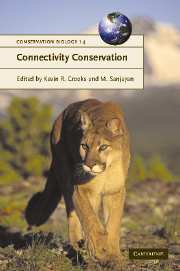Book contents
- Frontmatter
- Contents
- List of contributors
- Acknowledgements
- 1 Connectivity conservation: maintaining connections for nature
- PART I Approaches to connectivity research
- Introduction: Connectivity research—what are the issues?
- 2 Landscape connectivity: a return to the basics
- 3 Connectivity and metapopulation dynamics in highly fragmented landscapes
- 4 Genetics and landscape connectivity
- 5 Connectivity at the land–water interface
- 6 Influence of natural landscape fragmentation and resource availability on distribution and connectivity of gray wolves (Canis lupus) in the archipelago of coastal British Columbia, Canada
- 7 Migratory connectivity
- 8 Connectivity in marine ecosystems: the importance of larval and spore dispersal
- 9 Connectivity and wide-ranging species in the ocean
- 10 Hydrologic connectivity: a neglected dimension of conservation biology
- 11 Connectivity and ecosystem services: crop pollination in agricultural landscapes
- PART II Assessing connectivity
- PART III Challenges and implementation of connectivity conservation
- Index
- References
10 - Hydrologic connectivity: a neglected dimension of conservation biology
Published online by Cambridge University Press: 24 May 2010
- Frontmatter
- Contents
- List of contributors
- Acknowledgements
- 1 Connectivity conservation: maintaining connections for nature
- PART I Approaches to connectivity research
- Introduction: Connectivity research—what are the issues?
- 2 Landscape connectivity: a return to the basics
- 3 Connectivity and metapopulation dynamics in highly fragmented landscapes
- 4 Genetics and landscape connectivity
- 5 Connectivity at the land–water interface
- 6 Influence of natural landscape fragmentation and resource availability on distribution and connectivity of gray wolves (Canis lupus) in the archipelago of coastal British Columbia, Canada
- 7 Migratory connectivity
- 8 Connectivity in marine ecosystems: the importance of larval and spore dispersal
- 9 Connectivity and wide-ranging species in the ocean
- 10 Hydrologic connectivity: a neglected dimension of conservation biology
- 11 Connectivity and ecosystem services: crop pollination in agricultural landscapes
- PART II Assessing connectivity
- PART III Challenges and implementation of connectivity conservation
- Index
- References
Summary
INTRODUCTION
Hydrologic connectivity refers to water-mediated transfer of matter, energy, and/or organisms within or between elements of the hydrologic cycle (sensu Pringle 2001). While this property is essential to maintaining the biological integrity of ecosystems, it also serves to perpetuate the flow of exotic species, human-derived nutrients, and toxic wastes in the landscape. All too often, we have acknowledged the importance of hydrologic connectivity in hindsight – as a result of environmental crises. Examples range from: the transport of exotic species that disrupt the food webs of rivers and lakes (e.g., Stokstad 2003); to the occurrence of extremely high levels of persistent organic pollutants (e.g., polychlorinated biphenyls PCBs) that bioaccumulate in global “hotspots” such as the Arctic (e.g., Aguilar et al. 2002); to effects of dams which impede riverine transport of essential elements such as silicon to coastal regions – which has been implicated in coastal eutrophication and the creation of coastal dead zones (e.g., Humborg et al. 2000).
Management and policy decisions regarding land-use activities are often made in the absence of adequate information on hydrologic connectivity in the landscape. An important area of research is to understand how human alterations of this property (e.g., dams, stream flow regulation, water diversion, inter-basin water transfers, water extraction) influence ecological patterns on local, regional, and global scales. Half of the accessible global freshwater runoff has already been appropriated by humans and this could climb to 70% by 2025 (Postel et al. 1996).
- Type
- Chapter
- Information
- Connectivity Conservation , pp. 233 - 254Publisher: Cambridge University PressPrint publication year: 2006
References
- 13
- Cited by



